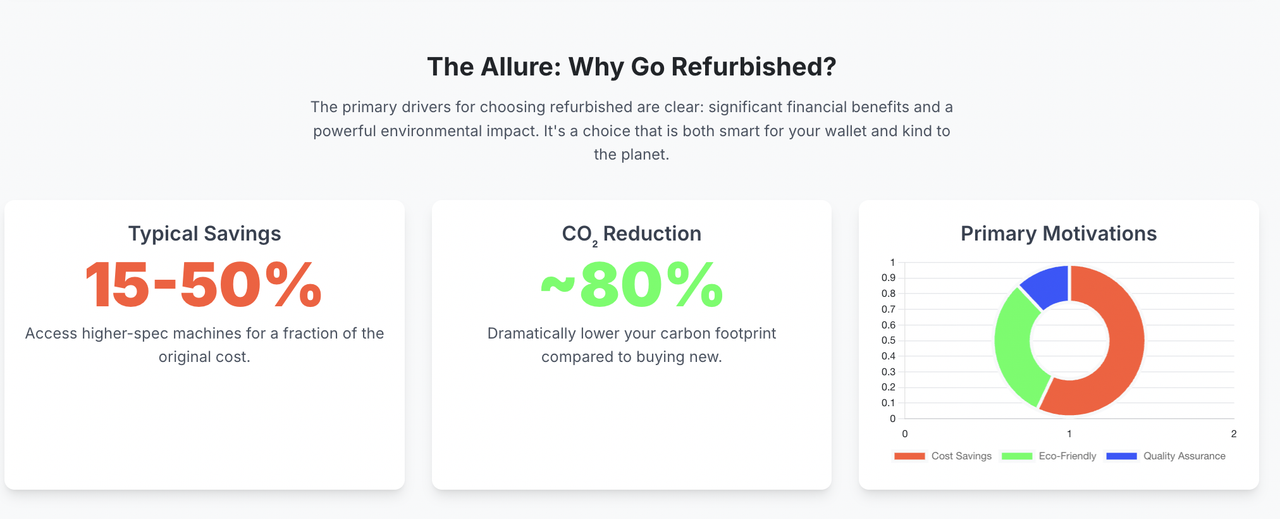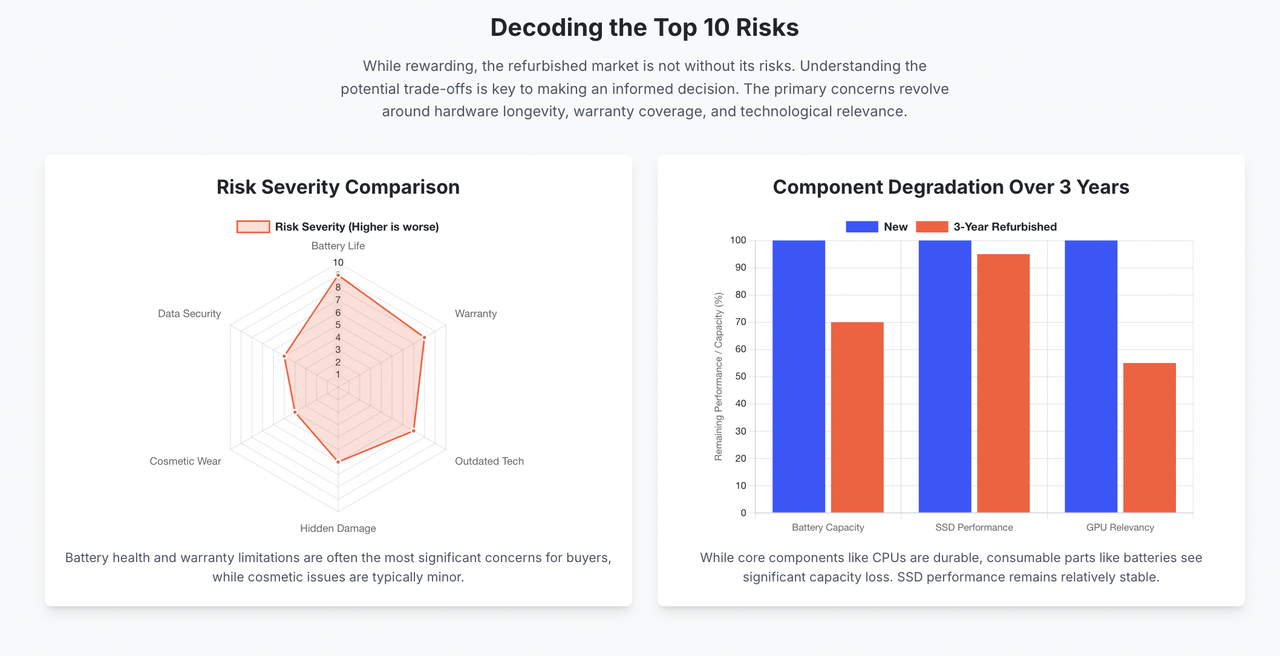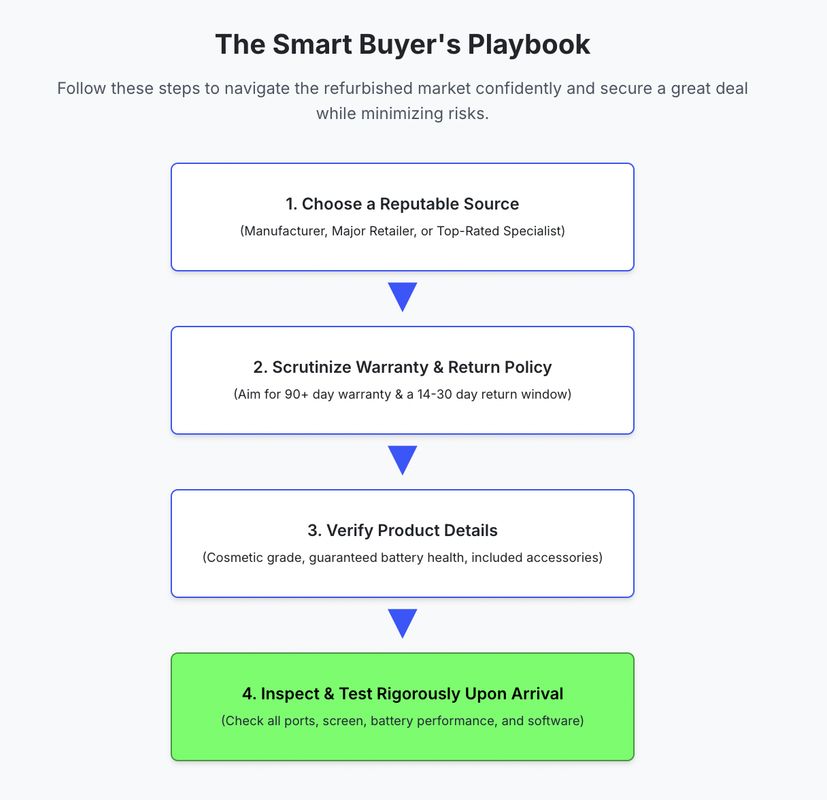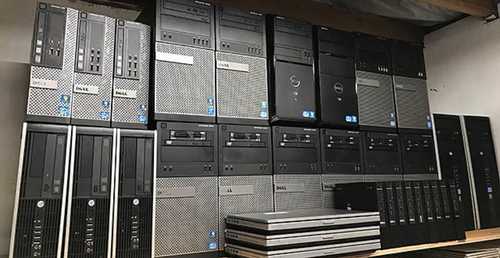Buying refurbished electronic devices like computers can feel a little risky if you’ve never done it before. But surprisingly, buying refurbished can be a smart and low-risk way to save a lot of money on a computer purchase.
So, should you buy a refurbished computer, and is it okay to do so?
This article will walk you through the pros and cons of refurbished devices, help you understand what to expect and where they come from, and give you some tips on buying refurbished computers.
While it’s typically safe to purchase certified refurbished goods, making sure you are aware of a few very important items can make all the difference between a a risky, poor buying experience and being happy with your new computer.

What Is A Refurbished Computer?
Refurbished computers are systems that are no longer able to be sold as ‘new’ and instead are offered for resale, often at a discounted price. All refurbished machines typically undergo repairs and testing by the manufacturer or refurbishing party to ensure they function as well as a ‘new’ item. Examples include:
- Returns or canceled orders which cannot be resold as new
- Defective returns which have been fixed and retested
- Items with small cosmetic defects like scratches or minor dents
The Difference Between Refurbished and Recertified
People often turn their nose up immediately upon hearing the word ‘refurbished’ or ‘recertified’ because they associate these labels with faults or prior use. While it’s true that the equipment may have been used previously, most will go through a vigorous refurbishment process which means you’ll end up with a near-new item.
Sometimes there may be a distinction between ‘refurbished’ and ‘recertified’, but usually the terms are used interchangeably. ‘Recertified’ does imply that the computer has undergone testing and quality checks again before being sold, but this is true of most refurbished items as well. Since the wording used by each different manufacturer will vary, it’s wise to research to find out exactly what you’re getting and make sure they include warranty periods.
Typical Refurbishment Involves Quality Assurance Testing, Cleaning, and Repair if Required
So what exactly does it mean when a computer is ‘refurbished’? As far as we know, there’s no real standard, but usually a refurbishment would involve a factory reset, cleaning, and testing of the machine at a minimum.
If the unit was faulty or damaged, a typical refurbishment process would include repairs or replacement of the faulty components before the unit is re-tested ensure the entire computer functions correctly again. Of course, such computers cannot legally be sold as ‘new’ items, and so they are returned to the market as a ‘refurbished’ computer and sold at a discounted price.
In some cases, a ‘refurbished’ computer may not have even been opened; it may have simply been returned or the order canceled by the customer. In these cases the item is essentially new, but again, legally it may not be able to be sold as a ‘new’ item so it makes its way to the ‘refurbished’ shelf for resale. Keep an eye out for these deals, which are often referred to as ‘open box’.
The refurbishment process can vary depending on who is doing the refurbishment, so you’ll need to do a little research into who is selling the refurbished goods to make sure you know what you’re getting.
You’ll want to ensure that any refurbished item has undergone the appropriate level of testing, quality assurance, cleaning and/or repair if relevant. Purchasing from larger, reputable manufacturers rather than third-party sellers is the best way to minimize your risk when purchasing a refurbished PC.
Should I Buy a Refurbished Computer?
Buying a refurbished computer in 2025 has become a lot more mainstream — and a lot safer — than it was just a few years ago. The industry has matured, standards have improved, and more reputable sellers have entered the space.
Yet, the decision to buy refurbished still requires a little know-how. If you’re thinking about saving money on your next laptop or desktop, here’s what’s new this year, what risks remain, and how to buy smart.
The Market Has Evolved
In the past, refurbished computers were often seen as risky second-hand options. Today, that’s changed. Manufacturers like Dell, HP, Lenovo, and Apple now have official refurbished programs where every device is inspected, repaired, tested, and resold with a warranty.
Many now follow clear grading systems, describing devices as “like new,” “excellent,” or “good,” based on cosmetic condition and performance.
Buyers have a clearer idea of what to expect, which has helped the market move away from the uncertainty it once had.
The Biggest Benefits
The main reason people buy refurbished in 2025 is simple: value for money. With prices of new computers climbing each year, refurbished options often cost 20 to 40 percent less while offering near-identical performance.
Many refurbished desktops and laptops now come with upgraded solid-state drives, fresh batteries, and updated operating systems, making them feel almost new out of the box.
The Risks to Watch Out For:

Even though the industry is stronger than before, there are still risks to be aware of. The biggest is component age.
A computer that’s been used for several years may have parts nearing the end of their lifespan, such as the battery or the storage drive. Always check the age of the hardware and make sure the components have been tested or replaced.
Another common issue is limited warranty coverage. Some sellers offer only 90-day warranties or exclude key components from coverage. Ideally, look for at least a six-month to one-year warranty.
It’s also important to check that the operating system is genuine and properly licensed. A few low-cost sellers may install unofficial copies that can cause security or update problems later.
Cosmetic wear is another factor to keep in mind. Scratches, dents, or missing accessories like chargers are common in lower-grade listings. If appearance or completeness matters to you, always check the condition grade carefully before buying.
Use this software to run benchmarks on your machine before buying or during your warranty period:
🧠 Overall System Benchmark Tools
-
PassMark PerformanceTest – Comprehensive tool that tests CPU, GPU, RAM, and disk performance.
-
PCMark 10 – Evaluates everyday performance (browsing, office apps, video calls, etc.).
-
Geekbench 6 – Quick and simple test for CPU and GPU power.
-
Novabench – Lightweight, free benchmark tool that gives easy-to-compare scores.
⚙️ CPU Benchmarks
-
Cinebench R24 – Industry standard for CPU rendering performance (single-core and multi-core).
-
CPU-Z Benchmark – Quick built-in CPU test with comparison database.
-
Prime95 – Tests CPU stability and thermal performance under stress.
🎮 GPU / Graphics Benchmarks
-
3DMark – Gold standard for gaming and graphics performance.
-
Unigine Heaven / Superposition – Great for stress-testing graphics cards.
-
FurMark – Pushes GPU to the limit (good for checking overheating issues).
💾 Storage Benchmarks
-
CrystalDiskMark – Measures SSD or HDD read/write speeds.
-
AS SSD Benchmark – Tests SSD performance without using system cache.
-
ATTO Disk Benchmark – Used by many manufacturers to test drive throughput.
🔋 Memory (RAM) Tests
-
MemTest86 – Detects RAM errors (bootable tool).
-
AIDA64 Extreme – Advanced diagnostics for memory and overall system info.
Where to Buy Safely in 2025
The best way to reduce your risk is to buy from trusted sources. Manufacturer outlets are generally the safest option because they handle the refurbishment process themselves. Retailers that have official “certified refurbished” programs are also reliable and usually offer solid warranties.

🇺🇸 United States
-
Lenovo Outlet
-
Amazon Renewed
-
Best Buy Refurbished
🇬🇧 United Kingdom
-
Dell UK Outlet
-
HP UK Refurbished
-
Laptop Outlet
🇨🇦 Canada
-
Dell Refurbished Canada
-
HP Certified Refurbished Canada
-
Lenovo Canada Outlet
-
Best Buy Refurbished Canada
🇦🇺 Australia
-
Dell Outlet Australia
-
HP Refurbished Australia
-
Lenovo Outlet Australia
🇳🇿 New Zealand
-
Dell Outlet New Zealand
-
HP Certified Refurbished New Zealand
-
Lenovo Refurbished New Zealand
-
PB Tech
-
PTL Computers
What to Check Before You Buy
Before hitting the buy button, make sure you go through this checklist:
-
Confirm how old the device is and which generation of processor it uses.
-
Check if the hardware supports the latest version of Windows or macOS.
-
Review the warranty length and what parts it covers.
-
Verify that the operating system license is genuine and transferable.
-
Ask about battery health or drive replacement if you’re buying a laptop.
-
Make sure the price difference compared to a new model is meaningful.
-
Check that you’re getting all necessary accessories, like the power adapter.
-
Read the return policy carefully in case the computer doesn’t match the description.
Common Questions About Refurbished Computers
Is it safe to buy refurbished in 2025?
Yes, as long as you buy from reputable sellers and verify the warranty and condition. The risk is far lower than it was a few years ago, especially with certified refurbished programs now in place.
How much money can I actually save?
Most buyers save between 20 and 40 percent compared to new models. The exact discount depends on the age and condition of the device, as well as whether it’s sold by the manufacturer or a third-party refurbisher.
Are refurbished computers slower?
Not necessarily. Many refurbished systems now include upgraded storage or fresh hardware that performs just as well as new machines for everyday tasks. Performance largely depends on the specs and not the fact that the device was refurbished.
What about software or security risks?
Good refurbishers completely erase old data, reinstall a fresh operating system, and update the BIOS or firmware. Still, it’s wise to reset or reinstall the OS yourself once you receive the computer for extra peace of mind.
Can I upgrade a refurbished computer later?
Yes. Many refurbished desktops and business-class laptops are highly upgradable. You can often replace the SSD, add RAM, or swap batteries easily, which extends their usable life.
What warranty should I expect?
The minimum should be 90 days, but the best sellers offer between six months and one year. Extended warranties are also available for an additional cost.
Should I buy refurbished from a marketplace or directly from the manufacturer?
Buying directly from a manufacturer’s outlet or a certified refurbisher is always safer. Marketplaces can be fine if the seller is reputable, but you’ll need to do more background checks on warranty, return policy, and condition.
Final Thoughts
Buying a refurbished computer in 2025 makes more sense than ever — but it still pays to be smart. The key is knowing where to shop and what questions to ask. Stick to reputable sellers, verify the warranty, and compare prices carefully. If you do, you can end up with a reliable, high-performance machine at a fraction of the price of new.
In short, refurbished computers are no longer a gamble — they’re a practical choice for buyers who want great performance, strong value, and a safer way to stretch their budget.
*Updated on 19 October, 2025. Older Article Below:
For all intents and purposes, refurbished machines are usually certified to function as well as a new machine. However, one caveat is that it does depend on who is doing the refurbishment, as the quality of the machine hinges on the fine details of the seller’s refurbishment procedure and quality assurance policies.
If you can verify that the refurbished computer is of an equal performance standard to its ‘new’ counterpart, and that you are at no disadvantage in buying refurbished over new, then we think it’s a great idea to purchase refurbished goods – if the price is discounted enough to cover any perceived risk. In most cases though, the risk is low as the buyer is protected by the seller’s warranty and returns periods.
Refurbished Computers Aren’t for Everyone
If you’re the type of person who doesn’t like the idea of someone having handled or even used your computer before you, or constantly trying to figure out what was wrong with your machine will keep you up at night, then you might be better off buying new.
Another thing to note is that occasionally refurbished computers may have small amounts of cosmetic damage such as dents and/or scratches (although note that this may not be true for all refurbished offerings, so check with the specific seller). If you’re not willing to accept this, then again, a refurbished machine may not be for you.
Finally, it’s likely that a refurbished computer has been shipped and handled a little more than a new computer off the shelf. While it’s unlikely, there is always a small risk that handling can damage components like hard drives which can be sensitive, so if you’re just not too keen on the idea of falling back on a warranty and would rather the certainty that comes with having a brand new computer which has been handled less, then you may be better off buying new.
The Pros and Cons of Refurbished Computers
Upsides
- You can a high-quality computer at a discounted price just because its no longer legally considered ‘new’
- Most refurbished computers may not have ever been faulty to begin with. A good number are simply returns due to buyer’s remorse
- The hardware in the units will have been tested more extensively than their ‘new’ counterparts – so the chances of you getting a faulty unit are lowered
- There’s little risk if you are protected by the seller’s warranty and returns policies
- Less environmental impact as items are not dumped, but instead refurbished and re-sold
Downsides
- You’ll never know the real reason why a refurbishment was necessary
- There’s usually going to be some unknown on the previous history of the computer – for instance it may have been shipped and handled more than a ‘new’ computer
- There can be a level of risk if you don’t do your homework about warranties and returns
- The availability of refurbished computers depends on the market
Refurbished Computer Purchasing Checklist
If you’re interested in buying a refurbished computer, we’ve put together a checklist of things to confirm to lessen your risk before going ahead with your purchase:
- Read the fine print about the seller’s refurbished computers – make sure you are happy with the previous history of items that are resold as refurbished goods
- Read the fine print about the seller’s refurbishment process – it should include testing as a minimum.
- Check the seller’s warranty period; is it as good as that of a new machine? Make sure there are no exclusions.
- Check the seller’s return policy; are you able to return the item for a full refund if you are not satisfied with it?
- Check if cosmetic damage/blemishes are expected on refurbished goods; and how they are covered by the returns policy if they aren’t to your satisfaction
- Compare the specifications/hardware of the refurbished product with the equivalent new product to make sure they match.
- Compare the price of the refurbished unit to the equivalent new unit.
Buying Tips
- Always buy from a manufacturer or otherwise large/reputable company.
- Make sure it makes sense to buy refurbished over new; always check the specifications on your refurbished purchase and make sure they match the comparable new product before comparing pricing.
- Only buy refurbished over new if the price difference is significant enough to justify the extra perceived risk. We’d suggest setting a target of at least 15% in price reduction to cover your extra hassle/research/potential risk.
- Make sure the warranty period offered is not less than if you were to buy the item new. Some manufacturer’s may also offer an extended warranty for an additional price.
- If you find a good deal, don’t wait around before you try and purchase – refurbished computers often get snapped up very quickly because they offer such great value.
- Some parts like laptop batteries or hard disk drives are a little more susceptible to wear with use and time. Make sure you have at least some idea of what the possible history of these components could have been before you purchase, and weigh up if the cost savings are worth the downside of having slightly used parts.
Know What You’re Buying
Not all deals are good deals, so make sure you know what you’re buying. Check the fine print and research the specifications of the computer that you’re looking at before agreeing to anything.
Some refurbished computers can use older hardware, which means that the ‘new’ equivalent may have already reduced in price – with the end result being that the low price that you’re seeing on your refurbished computer is not that great a deal after all.
To avoid getting suckered, always check the pricing on the equivalent ‘new’ computer for comparison’s sake.
Where to Find Refurbished Computers and Laptops
Acer
Here you’ll find official recertified Acer products including desktops, laptops and even monitors; the recertified items being those which have either been returned or previously opened (and having undergone cleaning and restoration to a functionally new state). The site is easy to search by category and shows you exactly how much you’re saving. Recertified products come with a 90 day limited warranty and 30 day returns policy.
Amazon
While not a computer manufacturer, Amazon can be a good place to get refurbished computer good due to its excellent returns policy. According to their website, ‘Amazon Renewed’ refurbished items are repaired and handled by qualified manufacturers or specialized third parties. Apart from being covered by Amazon’s usual returns policy, you are guaranteed a minimum of 90 days limited warranty on all purchases of recertified goods, and the particular item being sold may have a longer warranty period as well.
Apple
Apple offer a 1 year warranty on their refurbished products, and free shipping and returns as well. Certified refurbished products from Apple are pre-owned items which have been refurbished and tested by the manufacturer. Savings of 15% and up are not uncommon and you can even opt to extend the warranty on items purchased.
Dell Refurbished or Dell Outlet
Dell refurbished products are previously opened and used products, and as such, may have some minor cosmetic defects that do not affect performance. According to the website, you get the same warranty period as new purchases when buying refurbished.
HP
HP’s certified reconditioned goods come from a variety of sources including: demo products, cancelled/returned orders, faulty items which have been repaired, and overstocks. They offer a 1 year limited warranty with an option to extend.
Lenovo
Lenovo’s outlet website appears to have three separate categories: new, refurbished, and scratch and dent; however little information is given on the history of the devices and the general warranty offerings for refurbished items, however some of the individual deals we looked at had 1 year warranties on offer.
Newegg
Like Amazon, Newegg isn’t a manufacturer but their refurbished products do come from authorized repair facilities and are backed by Newegg’s return policy. You should expect that some of their refurbished goods may have light cosmetic blemishes or signs of wear.
In Summary: Is It Risky To Buy A Refurbished Computer?
We’d say no, it’s not risky to opt for a refurbished PC, as long as you do your research correctly and buy through a reputable company. Buying refurbished can be an excellent way to save a significant amount on your next computer purchase and especially if it’s a ‘open box’ sale and essentially is new.
Before you rush out though, remember that we do recommend only buying from the manufacturer directly or otherwise a large reputable company with a solid returns policy. Make sure you check the fine print so that you know exactly what you’re getting and use our buying checklist so that you can have good peace of mind.
Buying a refurbished machine has very little risk over a new computer, however new computers still offer the least amount of risk because you know they haven’t been shipped and handled multiple times before you get your hands on them. That being said, refurbished computers are definitely an option to keep in mind for those who enjoy a good bargain.

